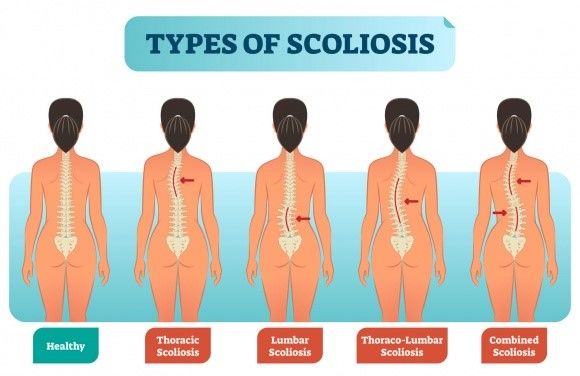What is a scoliosis and what can I do about it?
Have you ever noticed a curvature in your spine? Do you feel like your shoulders or hips are uneven when you look in the mirror? Have you ever been told you have a scoliosis?
A scoliosis is an abnormality in the curvature of the spine. It can occur at different areas in the spine, as shown in the picture below. A scoliosis commonly presents in childhood or adolescence and ranges in severity.
A physiotherapist will perform a physical exam to determine the type of scoliosis, which is important to know for the appropriate management of the condition. The two main types of scoliosis are:
- Structural – usually present from birth or develops at a very young age due to growth abnormalities in the spine
- Non-structural - being caused by muscular imbalances or posture
How do I know if my child has a scoliosis?
- When looking at the child from behind, a scoliosis presents as a C or S-shaped curvature somewhere along the spinal column
- A scoliosis commonly has a rotational component, too. A rotation of the vertebrae in the midback can cause one side of the ribcage to stick out more – this is often more noticeable when the person bends forward
- A child with a scoliosis may also complain of mild pain or discomfort in a certain area of the back
It is important to monitor the progression of a scoliosis in children and adolescents in order to ensure that it is managed appropriately. This can be done by having an x-ray of the spine every 6 months or so. The x-ray images are used to calculate the angle of the spinal curvature (the Cobb Angle) and how much it has increased since the last scan was done. This tells your therapist if the scoliosis is progressing, and if so, how quickly.
Management of a scoliosis
Exercise therapy
- Through research, several methods of exercise therapy have been designed to manage the milder forms of scoliosis
- A physiotherapist will choose the most appropriate exercise method for each individual, but all of the methods have a general aim to de-rotate, elongate and stabilize the spine in a three-dimensional plane
- Exercise therapy for mild scoliosis is focused around restoring muscular symmetry and alignment of posture with strength-based exercises and mobility techniques
What if exercise is not enough?
- If a scoliosis becomes more pronounced as a child grows, there may be a need for the child to wear a brace in order to help prevent worsening of the curvature
- Surgery may be required for severe scoliosis when the angle of the spinal curvature reaches a certain threshold – in this case, patients may also be experiencing quite severe respiratory issues
- A physiotherapist can also provide breathing exercises and thoracic mobilisation techniques in order to ease the effort required to breathe, in more severe cases
Surgical intervention is quite rare in patients with scoliosis, with less than 10% of individuals requiring surgery. It is important to consult with a specialist in spinal management in this case

